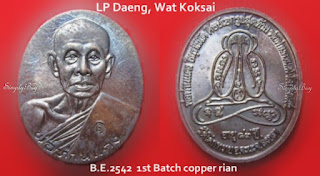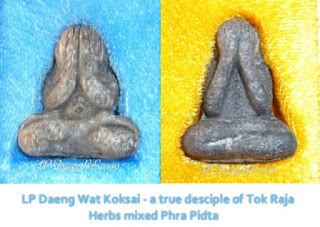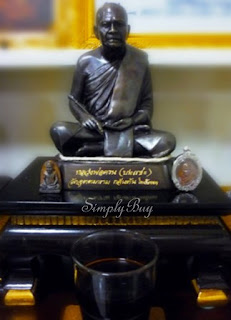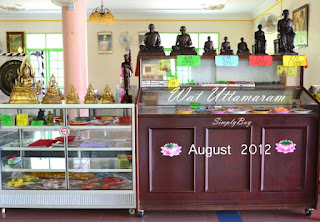Foreword
Namo Bodhisato Punnak Suwanno Patissimae
More than a hundred years ago, according to Repek kampong folks this temple was originally located at Lubok Jong when the young venerable was first ordained as a Sammanera Bhikku. Lubok Jong is situated not that far distance from Repek. Venerable Khron went for further studies in Pali and Buddhist examinations in Songkhla. Upon completing his monastic studies and spiritual assignments at several temples in Songkhla, he then requested for a transfer home to his birth village firstly relocated to Wat Kampong Dalam. It was believed that sometime from B.E. 2468 (A.D. 1925) onward Venerable Khron relocated Wat Bangsek and re-established Wat Uttamaram in Repek to further spread Buddhism and to teach Vipassana Kamathana meditation technique. Venerable Khron strongly believed in education as the source for knowledge.
Life was tough in the early days at Wat Uttamaram as it was surrounded by thick forested jungles and the only mode of transportation then is via its river networks. Today we can still see a small river at the temple entrance and another downstream river at the backyard. In addition to this geographical set-back, the temple ground was also inherited by devilish spirits and supernatural forces that constantly disturb temple residents. Venerable Khron had a tough time convincing new novices and ordained monks wanting to learn and practice Buddhism under his guidance to stay for longer period of time. That was the time when Venerable Khron began making his legendary ‘Tongkat’ wands that can perform miraculous cure for any type of ailments and they can be used to exorcise evil spirits that will not be discussed here.
Venerable Khron “Tok Raja” was greatly admired by the kampong Bomohs and they too learned from him sacred versus ‘Katha’, exorcism and healing ailments technique. The legendary "Tar Yai" or Tiger spirits owned by Tok Raja is symbolized by the tiger statues at the backyard of the temple facing the river stream. Tok Raja often called upon his kept spiritual pets when conducting any important ceremonies. Tok Raja's invulnerability and power stemmed from his knowledge in combining Malay Bomoh and Siamese Shaman technique.
One of the oldest and still living disciple Bomoh in Tok Raja’s era is Archan Kuan age 87 years (A.D. 2009) whom is also the younger brother of the late Chao Koon Chan, the second Abbot of Wat Uttamaram. Sadly Archan Kuan passed away on 16 Dec 2010.
Perhaps it is worth mentioning that despite Tok Raja’s high Vicha knowledge and attainment, he has a very erratic temper and observing the Precepts and monastic code of conducts strictly. In those days, the temple compound has a variety of fruit trees. The locals dare not dare to pluck any of these fruits within the temple vicinity fearing repercussion without the approval from Tok Raja. The villagers don’t even dare to touch any of these sweet fruits even though they are fully ripened and almost going to be rotten. When Tok Raja said ‘you all may eat now’, only then the villagers dare to take all the fruits to their heart’s content. The same goes for petty thieves whom commit acts of stealing valuables inside the temple will find it impossible to leave as though they are trapped within a giant maze and lost inside the temple ground. That was the miracles that Tok Raja could perform and are feared by many for some good reasons.
Peace and happiness began to surface in the village but not for long when war soon broke up. During World War 2 the Japanese Imperial Army invaded Malaya through amphibious landings and fought against the British in Kota Bharu the capital state in Kelantan. That was a very dangerous time to live in for everyone of different faith and religions. Local villagers often seek Tok Raja’s protection and blessings during this turbulent period. As a result of compassion Tok Raja created the first batch of Phra Pidta Phakhawan proven with good properties to protect oneself from all dangers “Klaew Klad” and impenetrability “Kong Kraphan”. It is an arduous process to make this first ever powerful and proven Pidta Phakhawan. As a result, only 99 pieces was produced based on the information gathered from Tok’s descendents. Soon after that Tok Raja again created his 2nd batch of Phra Pidta Phakhawan totaling 199 pieces. In those days, Tok never fix any price for people who have faith in him seeking his Pidta Phakhawan unlike today.
According to one of Tok’s great grand nephew, Tok will giveaway all his hand crafted Pidta based on fate and the real need of the person seeking it. When Tok said he will give away the Pidta the day after tomorrow, he will not give it any other day even when the requestor begged him.
Tok Raja had dedicated his entire life in spreading Buddhism teachings and helping people from all walks of life. On 19 November 1962 at the age of 86, sadly Tok passed away due to old age. But his lifelong dedication and service to the community and Sangha Order will never diminish in the heart of those whom knew him and have faith in him from the past till present.
With regards to Tok Raja's house where he was born and stayed as a child, Repek villagers could not confirm since it's more than 100 years ago. However, Tok's former residence inside the temple (behind the Main Shrine) is located on the 2nd upper floor. No visitors are allowed to enter his former bedroom because of a strange emitting force that is very powerful till today since he passed away. According to a source from one local Repek folk, even if someone were to sleep directly below Tok's former bedroom at the ground floor, he will not be able to sleep through the night as if some form of powerful energy interfering a good night sleep. What is more to sleep inside Tok's room. The same goes to Chao Koon Chan's former room too behind Tok's room on the upper floor. This strange phenomena is believed to be a direct result of a fully attained monks. The stairway leading to the upper floor is always locked and the rooms are used as the temple storage rooms to store amulets and other holy items.
Venerable Chao Koon Chan also widely known as ‘Ah Kong’ became the 2nd Chief Abbot at Wat Uttamaram after the demise of Tok Raja in 1962. Chao Koon Chan was also a native from Repek but he is not related to Tok’s family lineage. Chao Koon Chan was conferred the eccelestical title of Phra Vicaranayanmuni Nayaka Maha Thera by the Buddhist Sangha Council of Thailand for his services and contributions to Buddhist teachings. Subsequently he was also bestowed the title Lord Abbot of Kelantan state by H.R.H. Sultan of Kelantan in the 60’s.
Chao Koon Chan had brought many improvements to the community and had conducted various charities during his lifetime as the 2nd Chief Abbot. On the 30th day of November 1992 at 6.45 am, Chao Koon Chan passed away peacefully at age 84.
After the demise of Chao Koon Chan, Venerable Than Mit returned from abroad and became the 3rd Chief Abbot at Wat Uttamaram for almost 9 years until his demise. He is also the Chief Abbot of Wat Uttamayanmuni in Singapore at the same time. It was said that Than Mit followed Tok Raja’s advice to set-up Wat Uttamayanmuni after his demise to avoid any misunderstanding in the Sangha order.
Chau Khun Mit was born on Saturday, 27 April B.E. 2473 in the family of Mr Naisow Matnirat and Mdm Nangmok Matnirat in Kampung Repek, Pasir Mas, Kelantan, Malaysia. He is the single child of the family and is a relative of Tok Raja. Chau Khun Mit is a very effective communicator because he is fluent in Jawi, Malay, Thai and Chinese Hokkien dialect. With such a great language skills, he has no problem in conversing with devotees and to communicate with people around him. As a young man, Chau Khun Mit always enjoyed carpentry and gardening. Therefore, he is always involved in helping villagers and temples' repair work, maintenance and construction.
As a good practice and tradition in Thai Buddhism, CK Mit entered the Sangha Order to be ordained as a monk. CK Mit went to Wat Uttamaram for ordination and under the guidance of Tok Raja. Later, he further his Buddhism study in 'Rongrian Pet Nukkhun' Ampur Nongkhip, Pattani, Southern Thailand.
In B.E. 2500, he completed his studies and returned to Wat Uttamaram to continue his Buddhism practice. He also helped Tok Raja in administering Wat Uttamaram (together with CK Chan). After years of perseverance and effort in learning and studying Buddhism under the guidance of Chau Khun Khron, Chau Khun Mit was entrusted with the art of amulet making such as materials, amulet blessing ceremony and special katha from Chau Khun Khron. Thereafter, Chau Khun Mit began to make amulets for distribution to helpers and devotees as well as for fund-raising. His amulets include the infamous Phra Pidta, taolit B.E. 2505 in wahn, Rian Kao rebatch, Taolit B.E. 2506, etc.
When Tok Raja passed away in B.E. 2505, CK Mit was handed the 'Sacred Tongkat' (Mai Khru). Meanwhile, CK Chan was handed with another 'Sacred Tongkat' which is longer. CK Mit inherited some sacred materials and tools for amulet making notably Phra Pidta from Tok Raja.
Visitors can pay respect to CK Mit at the Chao Khun Mit's dedicated hall inside Wat Uttamaram compound. Another temple where visitors can pay respect to CK Mit is Wat Peyaram in Tangkak, Johor that is closely associated with Wat Uttamaram.
It is a well-known fact that Than Mit is related to Tok Raja family lineage and his birthplace is also in Repek. On the subject of impermanence “anicca” following the universal law of karma as taught by Lord Sakyamuni Gotama Buddha, Than Mit passed away on 25th May 2001.
The present Chief Abbot at Wat Uttamaram is Phrakhru Udomdhamma Patibhano or also widely known as Than Boon. For over 80 years since the humble beginning of Wat Uttamaram (Bangsek) initiated by Tok Raja, it has served its purpose as a learning centre for important Buddhist teachings and meditation subjects. This huge responsibility is passed on to Venerable Than Boon as the current temple Abbot to carry out its heritage in spreading Buddhism teachings and to serve humanity.
As a visitor to Wat Uttamaram, we must be grateful that unlike any other temples in Thailand, Than Boon can converse in local Malay and English language apart from the Thai language. People can converse with Than Boon easily and ask questions on any Buddhism subject matter. Venerable Than Boon displays high composure and benevolence despite how tired he maybe with temple activities and still kind to give blessing upon requests. Let us all wish Than Boon successfully bring the Dharma to all sentient beings and uphold Wat Uttamaram’s heritage for the benefit of all.
Although Wat Uttamaram had achieved strong admiration and recognition from neighboring Thailand, visiting Wat Uttamaram by travelling on a long distance journey may deter most people from getting there. In Kelantan there are nearly 20 Thai temples including Wat Uttamaram and it is a great opportunity for those who take interest in visiting Thai Buddhist temples to take the first initiative.
Firstly, we may want to ask ourselves what is Wat Uttamaram so famous for? This is where the infamous Tok Raja Pidta Phakhawan and Tongkat originated from. Both Pidta Phakhawan and Tongkat are so sacred and they are very famous all over Malaysia, Singapore and Thailand.
As Malaysian Buddhists following the Theravadian tradition, we must be grateful that we have our very own renowned Thai Buddhist temple in Kelantan that was also highly revered amongst Thais.
There are very few present gurus whom may have learned the sacred techniques of producing Phra Pidta Bangsek either directly or indirectly from Tok Raja. "Bangsek" is the old name of Wat Uttamaram and people can easily associate Pidta Bangsek with Tok Raja.
Pidta Bangsek is also the phim design where the Pidta in black color covers its eyes sitting in meditation. Present gurus that are said to have originated from Tok Raja's lineage are Than Thit of Wat Machimaram in Tumpat, Chao Koon Onn from Sungai Padi in Narathiwat, and LP Daeng of Wat Koksai.
If you have faith in Tok Raja, renting a Bucha is a good idea. Not many people are aware that Tok’s favorite beverage is Black Coffee (without sugar or cream). As a sign of respect and paying homage to Tok Raja’s bucha is to serve a glass of black coffee (without sugar) every morning and pray to Tok for his blessing. Of course in the event black coffee is not available, the alternative is always a glass of clear water to venerate Tok Raja. Other offerings such as betel nuts and leaves with tobacco, and white cooked rice with fried salted fish can also be placed at the altar to pay respect to Tok Raja. Hope this information is useful to anyone and by the merits of this sharing may you also find peace and success from Tok Raja’s bucha.
The other major obstacle faced by most temple goers is the lack of clear road directions to get to Kelantan. There are several options on how to get there either by land or air. The quickest way to get to Kelantan is of course by flight as there is one domestic airport at Pengkalan Chepa in Kelantan capital city Kota Bharu. The other popular choice of travel is to drive all the way to the North East Coast state of Kelantan.
For driving option, there are several routes depending where you are residing. To begin with, let’s emphasize on the starting point within the Klang Valley. From Petaling Jaya or Kuala Lumpur, we can take the journey either by Gerik or Gua Musang route.
Travel Route Option 1: via Gerik
1. Drive towards Ipoh using the North-South Highway.
2. Turn out at the Kuala Kangsar exit from highway. The remaining distance to Repek, Pasir Mas from this point should be approximately 300km.
3. At Kuala Kangsar follow the road sign to Gerik (TIMUR). This is a long and winding road going up hills as though you are on the way up to Genting Highlands. Mobile phone reception is weak and may be out of reach most of the duration.
4. Next look out for Jeli road sign and head towards Rantau Panjang.
5. At Rantau Panjang, you look for signboard direction to Pasir Mas.
6. Keep a look out for Repek signboard on the left shoulder of the roadside along the Pasir Mas road. Temple is approximately 15km away from Rantau Panjang immigration checkpoint.
7. Once you spotted Repek road sign, turn left and go till you see a T-junction. At the T-junction you will find a Police Station on your right side.
8. Turn right and not very far you will find a small shop lot name Satinni. Turn left after the shop and go straight up the kampong road till you cross a small bridge. Not far approximately 100 meters you will see Wat Uttamaram signboard.
Total distance from PJ to Wat Uttamaram = approx. 550km. Travel time duration is on average 7.5hrs with minimal stopover for refreshment. Travel duration is very much depending on the traffic condition along the trunk roads.
Travel Route Option 2: via Gua Musang
We have inserted important snapshots of road directions along this route for ease of navigation.
1. Drive towards Kuantan using the Karak Highway.
2. At the end of the Karak Highway after paying the toll, you must keep to your left and turn into Bentong. You will reach a T junction take the right turn towards Bentong town.
3. Follow signboard from Bentong head towards Raub.
4. After reaching Raub township, follow signboard to head towards Kuala Lipis.
5. It is a long journey from Kuala Lipis to Gua Musang and you will bypass a lot of kampong villages throughout the journey. Although this stretch may be long and winding, it will be very rewarding with beautiful sceneries along the way. Keep your speed limit check at cruising speed.
6. Upon reaching Gua Musang, look for signboard and head towards Kuala Kerai.
7. Next is to head toward Machang upon reaching Kuala Kerai.
8. From Machang go toward Tanah Merah. The traffic can be a slightly heavy at this Machang-Tanah Merah stretch.
9. Upon reaching Tanah Merah, simply follow the road that leads you into the small but lively town. You may want to have your lunch or take a quick snack. There will be 2 traffic lights. Just go straight to bypass this township. From the 2nd traffic light, going straight it will be another 30km before you reach the end where you will see a Round About. Turn 9 o’clock and you are on the Rantau Panjang highway (no need to pay toll).
10. Approximately 5 km you will see Hospital Pasir Mas signboard on your left. Immediately keep your vehicle to the right hand side and ready to take the next turning in front to the Right. You will see the small Repek and Wat Uttamaram individual signboard.
11. Go straight in and reach a T-junction. At the T-junction you will find a Police Station on your right side. Turn right at that T-junction. You are not very faraway from Wat Uttamaram.
12. After the T-junction, not very far you will find a small shop lot called Satinni (above). Turn left after this shop and go straight ahead the kampong road till you see a small bridge. Not far approximately 100 meters you will see Wat Uttamaram signboard.
Finally visitors will be greeted by a big entrance upon entering the temple compound.
Total distance from PJ to Wat Uttamaram = approx. 500km. Travel time average 7.5hrs with minimal stopover for refreshments. Travel duration is very much depending on the traffic situation along the trunk roads. It is advisable to start your journey by latest 6am in order to reach Wat Uttamaram or Kota Bahru by 1.30pm - 2.00pm.
For visitors going from northern parts e.g. Penang or Ipoh, it is advisable to take the Gerik route. A word of advice for first-timers: Perhaps the best time to visit Wat Uttamaram or any other temples in Kelantan is during off-festive season. Avoid going during temple festivals e.g. Kathina or any special blessing ceremony as there will be too many people and accommodation will also be a problem.
The best time to start your travel journey is before 6am to avoid heavy traffic. You should be able to reach Wat Uttamaram by latest 2.00pm depending how many stops you have made along the journey. Before proceeding with your journey, it is also advisable to arrange for hotel accommodation in advance based on your budget. Below are several hotels in Kota Bharu city center that is approximately 24km away from Wat Uttamaram; Crystal Lodge, Grand Riverview, Royal Guesthouse, Dynasty Inn. To go to Kota Bharu follow the road back to the Round About (where you came from Tanah Merah earlier) and look out for Kota Bharu direction.
For every avid amulet collectors as well as beginners who have never been to Kelantan, this is the chance to take a closer look by yourself at what is installed in Wat Uttamaram's amulet counter.
We would like to wish you a successful journey to discover the wonders and heritage of Kelantan’s most legendary temple made famous by Tok Raja’s Phra Pidta Phakhawan.
Tok Raja's Katha
Namo Tassa Bhagavato, Arahato, Samma Sambuddhasa (3x)
"Namo Bodhisato Punnak Suwanno Patissimae"
Sabbe Satta Sukhi Hontu!










































































No comments:
Post a Comment
Note: Only a member of this blog may post a comment.